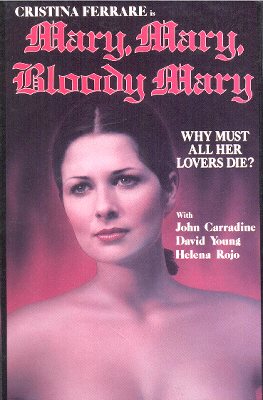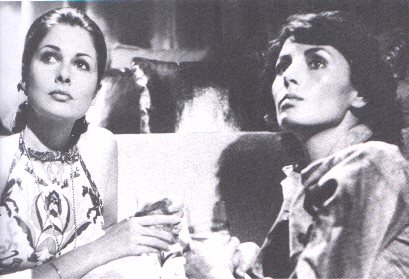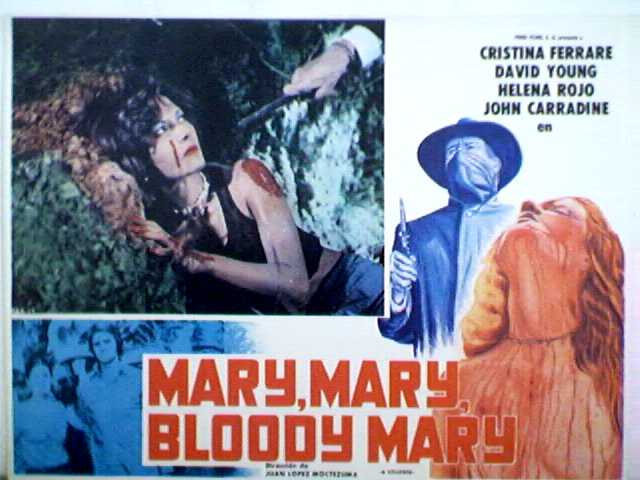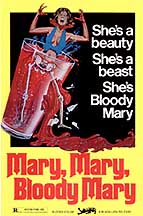
Translor Films Inc.--Proa Films S.A., in association with Cinema Management Inc. [U.S.-Mexican co-production]*
Executive Producer: Jaime Jiménez Pons; Producers: Robert Yamin, Henri Bollinger; Director: Juan López Moctezuma; Screenplay: Malcolm Marmorstein; Story: Don Rico, Don Henderson; Photography: Miguel Garzón; Music: Tom Bahler; Theme Song: Tom Bahler, Harry Shannon; Sung by: Tom Bahler; Associate Producers: Eduardo Moreno, Yolanda P. de Borchowsky; Production Manager: José Chávez; Prod. Supervisor: Robert Gale; Asst. Director: Rafael Villaseñor Kuri; Film Editor: Federico Landeros; Camera Asst: Antonio Ruiz J., Armando Castillón; Makeup: Victoria Celis; Sound Rec: Víctor Rojo; Re-recording: Ricardo Saldívar; Paintings: Rosa Rosenberg; Art Consultant: Leen van der Graaf; Union: STIC
*[(c) Cinema Management Inc.; one video release has "Black Lion presents" on the opening credits, but I am not sure where this came from]
CAST: Cristina
Ferrare (Mary Gilmore), David Young (Ben Ryder), John Carradine ("The
Man"--Mary's father), Helena Rojo (Greta Vidal), Arthur Hansel (Insp. Otis
Cosgrove), Enrique Lucero (Insp. Juanito Pons), Susana Kamini (hitch-hike
victim), José Angel Espinosa (Arthur Jensen, fisherman),
Ramón Armengod (doctor), Carlos Riquelme (Arnold, gallery owner),
Roger Cudney (Howard Miller), Jorge Humberto Robles (morgue attendant),
Reynaldo Rivera (grave-digger), José Calderón
(Pérez)

NOTES: Several years after completing La mansión de la locura, Juan López Moctezuma returned to filmmaking with Mary, Mary, Bloody Mary, a U.S.-Mexican co-production. The resulting film is quite good, although there are a few false notes. How López Moctezuma became involved in the project is not known. Executive producer Jaime Jiménez Pons had been a child actor who, in the 1970s, became a producer (interestingly enough, several of the other films he made--such as Santo vs. las lobas--also feature a police detective named "Inspector Pons" or "Ponce"), but the project seems to have been conceived in the United States, as evidenced by the writing credits: Malcolm Marmorstein had scripted a few movies, but the authors of the original story, Don Rico and Don Henderson, do not seem to have worked on any other films (there is a "Don Rico" who was a comic book artist, but whether this is the same person or not is unknown to me). Cristina Ferrare was a fashion model and actress, and David Young was also a Hollywood actor (albeit one with very few films to his credit). John Carradine seems to have been hired, as was often the case, strictly for his name value. His scenes could have been shot in one or two days, since his face is only seen clearly in the final sequence. The other performers were veterans of the Mexican film industry, chosen for their ability to speak English (although Arthur Hansel and Roger Cudney were gringos, albeit gringos who worked regularly in Mexican movies). Susana Kamini, who had appeared in a small role in La mansión de la locura, shows up in a good sequence--entirely in Spanish--as a murder victim. It's also interesting to see former leading man and singer (and occasional movie producer himself) Ramón Armengod in a cameo as the medical examiner, his last screen appearance before his death.
The problems I have with Mary, Mary, Bloody Mary are minor. Cristina Ferrare's performance is disturbing, although the script also contributes to its uneven quality--she's a cold-blooded killer in some scenes, but alternately appears vulnerable and even hysterical (the two sequences in which she is confronted by her father are a case in point: she stands still and screams in fear, in a very annoying manner). Sometimes she's good, but there's just something a little off about Ferrare's acting and it affects the film. On the plus side, she is very beautiful and appears unclad several times. Another minor bone I have to pick with the filmmakers are the gratuitous--and not very realistic--shots of blood pumping from the neck wounds of Mary's victims, which appear to have been included just so audiences would know this was a "real" horror movie. Finally, the aforementioned use of Carradine reminds one a little of Bela Lugosi--and his double--in Plan 9 from Outer Space. There's a fleeting glimpse of Carradine's face (I think) in the scene where he kills Susana Kamini, but otherwise it's only clearly Carradine in the last sequence. This makes some sense, since the filmmakers wanted to save the shock value of his crusty facial makeup, but there is something annoying about using Carradine's name and only showing him for about two minutes.
The film opens at night; Mary Gilmore's VW van breaks down in the midst of a storm, and she seeks shelter in an old house. Trying to use the telephone, she's startled when someone grabs her from behind. Fleeing outside, Mary eventually confronts her assailant: Ben Ryder, an American who is hitch-hiking through Mexico. He apologizes for scaring her, and they agree to spend the night in the house (on separate floors). Unable to sleep, Mary has a flashback: she was in the home of Howard Miller, an employee of the American Embassy in Mexico. As they make love, Mary pulls a long hairpin (more like a spike or a knitting needle) from her hair and stabs Howard to death, then drinks blood from a gaping wound on his neck.
FBI agent Cosgrove arrives to investigate the case. He is teamed with Inspector Pons of the Mexican police. The medical examiner says the body has been drained of blood. Meanwhile, Ben helps Mary fix her van, and she offers him a ride. They go to the beach (this sequence, which immediately follows the credits, begins with a upside-down closeup of a bleeding, screaming man being carried by some friends: he's a fisherman who has been bitten by a shark, which is then killed and left on the beach by the other men). While Ben is away, Mary offers a fisherman some drugged coffee; he struggles, knocking her hairpin from her hand, but she manages to stab him to death with a knife, then drinks his blood. Later, Ben goes back with Mary to her house. There is a painting of a man on the wall (a rather stylized portrait of John Carradine as he appeared in House of Dracula), which Mary says is her father: he died when she was young, and she painted the picture from memory.
Cosgrove and Pons examine the fisherman's body in the morgue. Pons
says at least a dozen Mexicans have also been slain in this way. He later
adds: "If what I think is true, the body count is staggering." That
night, intercut with shots of Ben and Mary making love in her house, a
figure dressed in black enters the morgue to look at the body, and kills
the morgue attendant with a switchblade, then drinks his blood. 
Mary's paintings are going to be sold at the art gallery run by the gay Arnold and the lesbian Greta. Greta tells Mary: "I kept wondering why you never attached yourself to a man," and Mary replies: "You kept wondering why I never attached myself to you." Later, Mary points out a skull-like sculpture of the ancient goddess Coatlicue to Ben. That night, there is a reception at the gallery. Greta sends Ben off to buy some more tequila for the guests, leaving Mary stranded. Greta convinces her to come home with her: "Do you need him, or do you need someone?" Mary is reluctant, but eventually winds up in a bubble bath with Greta. They embrace, and there is a dissolve to Greta's corpse, its neck slashed. The police question Mary: "Why do you think she'd leave the gallery in the middle of an important showing?" "Sex," Mary says. Ben, who says he was too drunk to remember anything, is a suspect.
Meanwhile, a young woman is stranded at a roadside cafe by some "friends," who stick her with the check and drive off. Hitch-hiking, she is picked up by a masked figure in black, driving a green Cougar. She screams for help, and eventually tumbles out of the car on a side road. Fleeing through the woods, she's tracked down and stabbed to death by the man in black, who then drinks her blood. When Mary sees the story in the newspaper the next day, she is shocked. Ben thinks it is the same killer, but Mary knows better. That night, the man in black enters Mary's house but flees when Mary and Ben come back; later, Mary gets a phone call. Someone says "Mary...Mary..." then hangs up.
The next day, Mary is painting a landscape scene in the mountains, when
the green Cougar appears and tries to run her down. Ben follows in Mary's
van, but the Cougar doubles back. The man in black emerges, pointing his
finger at Mary, and seems about to unmask, when Ben returns. The man
escapes. Mary and Ben embrace, and the camera lingers on a closeup of her
hairpin... Later, the man in black kills a costumed reveler, dons the
disguise, and tries to kidnap Mary during a street fair. The man stabs a
grave-digger to death as Mary flees through a graveyard. Ben and Mary are
taken to the police station where Ben is once again given a hard time, but
they are eventually released.

That night, Mary is restless and tries to leave without Ben's knowledge, but he insists on going with her. Cosgrove follows, stranding Pons, who is knocked down by the man in black as he pursues in the Cougar. The three vehicles head into the country. Ben drinks some of Mary's drugged coffee and passes out. She drags him into a field and prepares to stab him with her hairpin. Cosgrove shoots at the Cougar and it drives off the road in flames. The man in black is thrown clear, and he stabs Cosgrove to death when the FBI man comes to investigate. Mary (rather improbably nearby) recognizes the man in black as her father, whose face is horribly disfigured. He says "My veins have taken over my body...This is your future, Mary, if I permit you to live...There is only one cure for this misery: death." Ben revives and tries to save her, but is knocked over an embankment. He retrieves Cosgrove's pistol and shoots the man to death. Mary, in a frenzy, runs to drink his blood, and stabs Ben when he tries to stop her. There is a very nice crane shot, pulling out to an extreme high-angle longshot of Mary and the two dead bodies.
Back in the city, Mary tells Inspector Pons she is going to move
somewhere else, to try and forget.

Mary, Mary, Bloody Mary is often referred to as a "vampire film without vampires." The exact malady that she and her father suffer from is never clearly explained: Carradine's speech about his "veins" and his brain being crushed is hardly enlightening. Both Mary and her father want blood, but there is only a slight suggestion that they must have it to live (Mary eats and drinks normally, and apparently can go for some time without drinking blood, but on her last night with Ben she does lie awake, tormented by images of Coatlicue; Ben's insistence on accompanying her is the reason she decides to drink his blood, although she clearly would prefer to kill a stranger). In any case, there isn't any supernatural component of their "vampirism"--the references to Coatlicue are metaphorical allusions rather than explanations.
The picture is smoothly put together and has some stylish touches,
especially in the transitions from one scene to another. The shock cut to
the shark attack victim is one, while other scenes are heralded by a
closeup of a bejeweled skull, the closeup of Greta's corpse (her murder
isn't shown), and so on. Mary's paintings (with the exception of the
portrait of her father) are rather Dali-like representations of brains,
hearts, animals, caverns, tunnels, etc. López Moctezuma isn't able
to do much with the mise en scene given the contemporary
setting--La mansión de la locura and Alucarda are
much more flamboyant in their design--but the overall look of the picture
is satisfactory.

One interesting aspect is the inclusion of two gay characters: Arnold is almost an effeminate stereotype, but still a sympathetic character; Greta, originally depicted as a predatory lesbian, later becomes quite sympathetic herself. She is obviously infatuated with Mary and plots to get her alone, but she seems more lonely and lovelorn than evil or scheming. There isn't much "local color" in Mary, Mary, Bloody Mary: everybody speaks English (with the exception of the Susana Kamini sequence and the murder of the morgue attendant), and the feria scene is the only one which really seems like it takes place in a foreign country (although I guess it could have been set in New Orleans during Mardi Gras!).
Mary, Mary, Bloody Mary is an interesting and well-made film,
although not a great one.